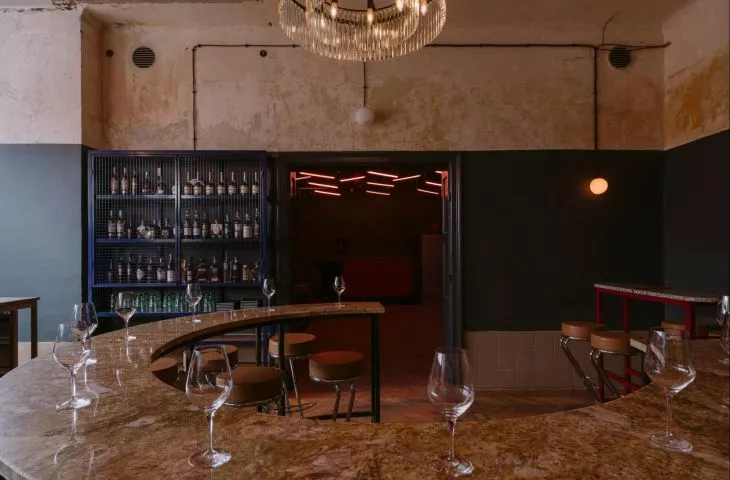Vanity is a dance club located in a historic building in the center of Poznań. "The mysterious building conceals within its walls an unprecedented combination of elegant interiors, the highest standards and music," - write the venue's owners on their website. The author of the design for this historic interior and its furnishings is Adam Wiercinski of wiercinski-studio.
The premises occupy an area of five hundred square meters. Due to the historic nature of the place, the designers decided to uncover and leave traces of the past, such as oak parquet floors or stucco, remove non-original partitions and colorfully unify the background.
The original oak parquets and stuccowork were preserved in the interior
Photo: PION Studio
In the original division of rooms, the architects wrote a new, bar-music function of the premises. Running from the entrance area, a long, dark corridor is decorated with stucco accentuated with neon rings. It leads successively to the checkroom, VIP room, toilets and a cocktail room connected with a small dance hall. The dance hall is illuminated by an installation of tubes alluding in shape to the pattern of the preserved herringbone floor. A geometric chandelier with a composition of glass shades hangs above the corridor shot bar.
The dance hall is illuminated by an installation of tubes alluding in shape to the pattern of the preserved herringbone floor
photo: PION Studio
Deep inside the premises is a richly decorated ballroom with a stage with a total area of one hundred and thirty square meters. The original brass chandeliers in this space have been enhanced with steel structures, a ceramic plinth running around the perimeter of the entire club and mirrors intensifying the height of the space. A neon sign indicating 11:55 pm hangs above the stage, suggesting that time has stopped here.
Most of the venue's windows have been soundproofed and covered with mirrors arranged in narrow strips, which, as the designer emphasizes, intensifies the perception of the historic space bathed in neon colors. The only room with access to daylight is a cocktail lounge with a centrally located circular table.
The furniture was made by local craftsmen
photo: PION Studio
The architects designed a series of fixtures and furniture for the venue, including bars made by local artisans with mirrored fronts, geometric chandeliers, wall-hung hockers with tables, benches, tables, bookcases or a guest stand crowning the corridor.
Classic elegance contrasts with the geometric forms of the designed furniture, which, tinged with neon colors, give the interior a modern, club-like atmosphere. For the project we invited two local street artists: Someart and Dumin, and we gave them part of the corridor wall to introduce yet another style that totally breaks the historical background and our design language. Artist Grzegorz Bibro is responsible for the neon installations," adds Adam Wiercinski.
Someart and Dumin's works in the corridor and Gregory Bibro's neon signs
photo: PION Studio
Ola Kloc: What was the main inspiration for this project?
Adam Wiercinski: I was inspired by the existing historic space and this set the direction to create a series of original furniture and fill the interior with them without interfering with the original elements.
Ola: What were the investor's expectations and needs?
Adam: The investor, of course, needed to accommodate the established function while in terms of design ideas and aesthetics we understood each other very well.
shot bar and a fragment of the corridor
photo: PION Studio
Ola: What kind of interior atmosphere did you want to achieve when choosing colors, materials and fabrics?
Adam: The background had to be dark because of the club function, while the colors of the designed elements remained in subdued hues to fit in with the elegant historic environment, which changes strongly anyway with neon colors.
Ola: How did you come up with the idea to invite street artists and Grzegorz Bibro to work together?
Adam: I have already worked with Grzegorz Bibro on other projects and we understand each other well artistically. I also know Streetartists primarily from street works and we were at ease that we could give them a free hand.











































































